For the 2025 school year, there is 1 public high school serving 122 students in Council School District. This district's average high testing ranking is 2/10, which is in the bottom 50% of public high schools in Idaho.
ÎÛÎÛÂþ» High School in Council School District have an average math proficiency score of 27% (versus the Idaho public high school average of 38%), and reading proficiency score of 37% (versus the 58% statewide average).
ÎÛÎÛÂþ» High School in Council School District have a Graduation Rate of 70%, which is less than the Idaho average of 79%.
The school with highest graduation rate is Council Jr/sr High School, with 60-79% graduation rate. Read more about public school graduation rate statistics in Idaho or national school graduation rate statistics.
Minority enrollment is 6% of the student body (majority Hispanic and Black), which is less than the Idaho public high school average of 26% (majority Hispanic).
Overview
This School District
This State (ID)
# Schools
2 Schools
297 Schools
# Students
294 Students
131,407 Students
# Teachers
19 Teachers
7,335 Teachers
Student : Teacher Ratio
15:1
15:1
District Rank
Council School District, which is ranked within the bottom 50% of all 172 school districts in Idaho (based off of combined math and reading proficiency testing data) for the 2021-2022 school year.
The school district's graduation rate of 60-79% has increased from 50% over five school years.
Overall District Rank
#155 out of 173 school districts
(Bottom 50%)
(Bottom 50%)
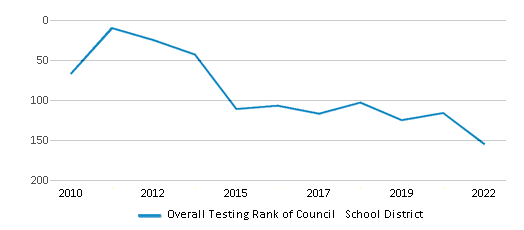
Math Test Scores (% Proficient)
25-29%
42%

Reading/Language Arts Test Scores (% Proficient)
30-34%
55%

Science Test Scores (% Proficient)
40-44%
41%
Graduation Rate
60-79%
80%
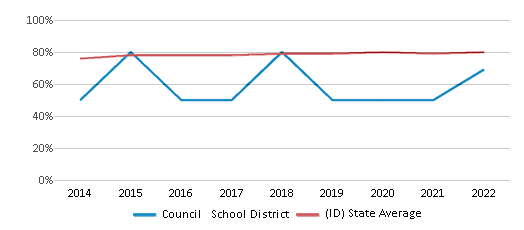
Students by Ethnicity:
Diversity Score
0.14
0.41
# American Indian Students
4 Students
1,379 Students
% American Indian Students
1%
1%
# Asian Students
3 Students
1,547 Students
% Asian Students
1%
1%
# Hispanic Students
11 Students
24,546 Students
% Hispanic Students
4%
19%
# Black Students
4 Students
1,521 Students
% Black Students
1%
1%
# White Students
272 Students
97,813 Students
% White Students
93%
75%
# Hawaiian Students
n/a
404 Students
% Hawaiian Students
n/a
n/a
# Two or more races Students
n/a
4,210 Students
% of Two or more races Students
n/a
3%
Students by Grade:
# Students in PK Grade:
13
127
# Students in K Grade:
20
2,315
# Students in 1st Grade:
24
2,509
# Students in 2nd Grade:
22
2,614
# Students in 3rd Grade:
26
2,612
# Students in 4th Grade:
19
2,604
# Students in 5th Grade:
22
2,679
# Students in 6th Grade:
26
3,353
# Students in 7th Grade:
24
6,307
# Students in 8th Grade:
22
6,560
# Students in 9th Grade:
29
25,461
# Students in 10th Grade:
22
25,794
# Students in 11th Grade:
13
24,843
# Students in 12th Grade:
12
23,629
# Ungraded Students:
-
-
District Revenue and Spending
The revenue/student of $11,697 is higher than the state median of $10,185. The school district revenue/student has stayed relatively flat over four school years.
The school district's spending/student of $10,299 is higher than the state median of $9,364. The school district spending/student has stayed relatively flat over four school years.
Total Revenue
$3 MM
$3,215 MM
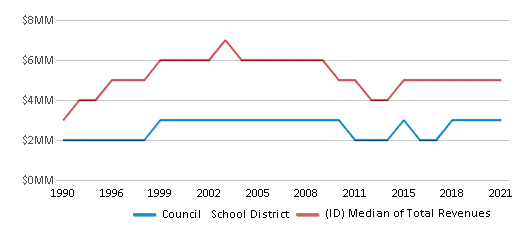
Spending
$3 MM
$2,956 MM
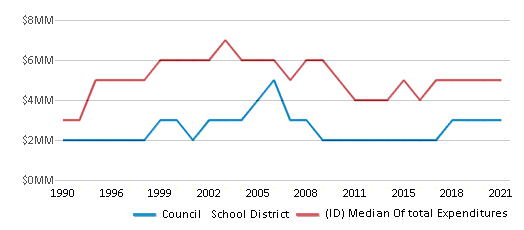
Revenue / Student
$11,697
$10,185
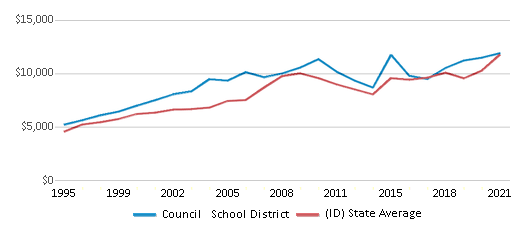
Spending / Student
$10,299
$9,364
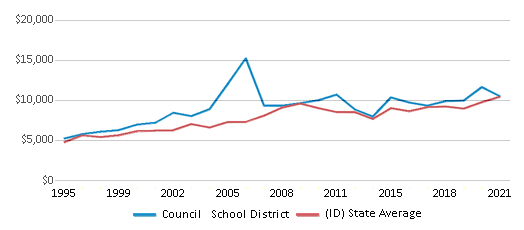
Best Council School District ÎÛÎÛÂþ» High Schools (2025)
School
(Math and Reading Proficiency)
(Math and Reading Proficiency)
Location
Grades
Students
Rank: #11.
Council Jr/sr High School
(Math: 25-29% | Reading: 35-39%)
Rank:
Rank:
2/
Bottom 50%10
101 East Bleeker Avenue
Council, ID 83612
(208) 253-4217
Council, ID 83612
(208) 253-4217
Grades: 7-12
| 122 students
Recent Articles

Year-Round Or Traditional Schedule?
Which is more appropriate for your child? A year-round attendance schedule or traditional schedule? We look at the pros and cons.

Why You Should Encourage Your Child to Join a Sports Team
Participating in team sports has a great many benefits for children, there is no doubt. In this article you will learn what those benefits are.

White Students are Now the Minority in U.S. ÎÛÎÛÂþ» Schools
Increasing birth rates among immigrant families from Asia and Central and South America, combined with lower birth rates among white families, means that for the first time in history, public school students in the United States are majority-minority. This shift in demographics poses difficulties for schools as they work to accommodate children of varying language abilities and socio-economic backgrounds.





